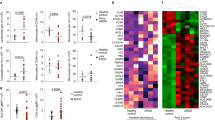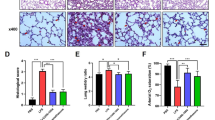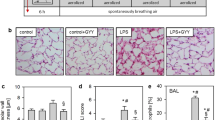Abstract
In immature or injured lungs, impaired alveolar gas exchange forces the use of elevated levels of inhaled oxygen to maintain life. But, at high concentrations oxygen induces lung injury, edema, and bronchopulmonary dysplasia, probably by stimulating the generation of reactive oxygen radicals and subsequent neutrophil infiltration. In addition to regulating neutrophil diapedesis, intercellular adhesion molecule-1 (ICAM-1) expression is marked on inflamed alveolar epithelium, suggesting a role for ICAM-1 in oxygen-induced, neutrophil-mediated parenchymal damage. To test this, we evaluated the rat anti-mouse ICAM-1 monoclonal antibody YN 1/1.7 in 2 protocols of oxygen-induced toxicity in adult, male Balb-c mice: ≥95% O2 for 84 hr and ≥95% O2 for 60 hr followed by 48 hr at 21% (ambient) O2. YN1/1.7 treatment partially attenuated the neutrophil infiltration, lung damage (lavage lactate dehydrogenase [LDH] activity) and dysfunction (reductions in respiratory system compliance [Crs] and diffusion capacity of the lungs for carbon monoxide [DLco] in the 84 hr exposure protocol. In the milder 60 hr exposure protocol, YN1/1.7 completely blocked the oxygen-induced lung dysfunction (reductions in Crs and DLco). These results confirm the contribution of leukocytes in the pathogenesis of pulmonary oxygen toxicity and indicate that antagonism of ICAM-1 may provide a therapeutic approach to reducing hyperoxic lung injury and dysfunction.
Similar content being viewed by others
References
Argenbright LW, Letts LG, Rothlein R (1991) Monoclonal antibodies to the leukocyte membrane CD18 glycoprotein complex and to intercellular adhesion molecule-1 inhibit leukocyteendothelial adhesion in rabbits. J Leukocyte Biol 49:253–257
Arieli R (1988) Oxygen toxicity is not related to mammalian body size. Comp Biochem Physiol 91A:221–223
Barton RW, Rothlein R, Ksiazek J, Kennedy C (1989) The effect of anti-intercellular adhesion molecule-1 on phorbol-ester-induced rabbit lung inflammation. J Immunol 143:1278–1282
Bowman CM, Butler EN, Repine JE (1983) Hyperoxia damages cultured endothelial cells causing increased neutrophil adherence. Am Rev Respir Dis 128:469–472
Boyce NW, Campbell D, Holdsworth SR (1989) Granulocyte independence of pulmonary oxygen toxicity in the rat. Exp Lung Res 15:491–498
Clark JM, Lambertsen CJ (1971) Pulmonary oxygen toxicity: a review. Pharmacol Rev 23:37–133
Comroe JH, Dripps RD, Dimke PR, Deming M (1945) Oxygen toxicity: the effects of inhalation of high concentrations of oxygen for twenty-four hours on normal men at sea level and simulated altitude of 18,000 feet. JAMA 128:710–717
Cramer R, Soranzo MR, Dri P, Menegazzi R, Pitotti A, Zabucchi, G, Patriarca P (1984) A simple reliable assay for myeloperoxidase activity in mixed neutrophil-eosinophil cell suspensions: application to detection of myeloperoxidase deficiency. J Immunol Methods 70:119–125
Crapo JD (1986) Morphologic changes in pulmonary oxygen toxicity. Annu Rev Physiol 48:721–731
Crapo JD, Freeman BA, Barry BE, Turrens JF, Young SL (1983) Mechanisms of hyperoxic injury to the pulmonary microcirculation. Physiologist 26:170–176
Crouse DT, Cassell GH, Waites KB, Foster JM, Cassady G (1990) Hyperoxia potentiates Ureaplasma urealyticum pneumonia in newborn mice. Infect Immun 58:3487–3493
Das DK, Bandyopadhyay D, Hoory S, Steinberg H (1988) Role of polymorphonuclear leukocytes in hyperoxic lung injury. Prevention of neutrophil influx into the lung endothelium during oxygen exposure by ibuprofen. Biomed Biochim Acta 47:1023–1036
Davis WB, Rennard SI, Bitterman PB, Crystal RG (1983) Pulmonary oxygen toxicity: early reversible changes in human alveolar structures induced by hyperoxia. N Engl J Med 309:878–883
Depledge MH, Collis CH, Barrett A (1981) A technique for measuring carbon monoxide uptake in mice. Int J Radiation Oncol Biol Phys 7:485–489
Dorkin HL, Jackson AC, Strieder DJ, Dawson SV (1982) Interaction of oscillatory and unidirectional flows in straight tubes and an airway cast. J Appl Physiol 52:1097–1105
Dustin ML, Rothlein R, Bhan AK, Dinarello CA, Springer TA (1986) Induction by IL I and interferon-g: tissue distribution, biochemistry, and function of a natural adherence molecule (ICAM-1). J Immunol 137:245–252
Forster RE, Fowler WS, Bates DV, Van Lingen B (1954) The absorption of carbon monoxide by the lungs during breath holding. J Clin Invest 33:1135–1145
Fox RB, Hoidal JR, Brown DM, Repine JE (1981) Pulmonary inflammation due to oxygen toxicity: involvement of chemotactic factors and polymorphonuclear leukocytes. Am Rev Respir Dis 123:521–523
Frank L, Groseclose E (1982) Oxygen toxicity in newborn rats: the adverse effects of undernutrition. J Appl Physiol 53:1248–1255
Gross NJ, Smith DM (1981) Impaired surfactant phospholipid metabolism in hyperoxic mouse lungs. J Appl Physiol 51:1198–1203
Harada RN, Vatter AE, Repine JE (1984) Macrophage effector function in pulmonary oxygen toxicity: hyperoxia damages and stimulates alveolar macrophages to make and release chemotoxins for poly morphonuclear leukocytes. J Leukocyte Biol 35:373–383
Harning R, Pelletier J, Lubbe K, Takei F, Merluzzi VJ (1991) Reduction in the severity of graft-versus-host disease and increase survival in allogeneic mice by treatment with monoclonal antibodies to cell adhesion antigens LFA-1 alpha and MALA-2. Transplantation 52:842–845
Horley KJ, Carpenito C, Baker B, Takei F (1989) Molecular cloning of murine intercellular adhesion molecule (ICAM-1). EMBO 8:2889–2896
Jackson AC, Watson JW (1982) Oscillatory mechanics of the respiratory system in normal rats. Respir Physiol 48:309–322
Jackson RM (1990) Molecular, pharmacologic, and clinical aspects of oxygen-induced lung injury. Clin Chest Med 11:73–86
Krieger BP, Loomis WH, Czer GT, Spragg RG (1985) Mechanisms of interaction between oxygen and granulocytes in hyperoxic lung injury. J Appl Physiol 58:1326–1330
Laughlin MJ, Wild L, Nickerson PA, Matalon S (1986) Effects of hyperoxia on alveolar permeability of neutropenic rabbits. J Appl Physiol 61:1126–1131
Martin WJ, Gadek JE, Hunninghake GW, Crystal RG (1981) Oxidant injury of lung parenchymal cells. J Clin Invest 68:1277–1288
Ogden BE, Murphy S, Saunders GC, Johnson JD (1983) Lung lavage of newborns with respiratory distress syndrome: prolonged neutrophil influx is associated with bronchopulmonary dysplasia. Chest 83:315–335
Ohtsu N, Ariagno RL, Sweeney TE, Davis L, Moses L, Petriceks R, Daehne I, Bensch K, Northway WM Jr (1989) The effect of dexamethasone on chronic pulmonary oxygen toxicity in infant mice. Pediatr Res 25:353–359
Parrish DA, Mitchell BC, Henson PM, Larsen GL (1984) Pulmonary response of fifth component of complement-sufficient and -deficient mice to hyperoxia. J Clin Invest 74:956–965
Raj JU, Hazinski TA, Bland RD (1985) Oxygen-induced lung microvascular injury in neutropenic rabbits and lambs. J Appl Physiol 58:921–927
Rinaldo JE, English D, Levine J, Stiller R, Henson J (1988) Increased intrapulmonary retention of radiolabeled neutrophils in early oxygen toxicity. Am Rev Respir Dis 137:345–352
Rothlein R, Dustin ML, Marlin SD, Springer TA (1986) A human intercellular adhesion molecule (ICAM-1) distinct from LFA-1. J Immunol 137:1270–1274
Sackner MA, Canda J, Hirsch MS, Zapata A (1975) Pulmonary effects of oxygen breathing. A six-hour study in normal men. Ann Intern Med 82:40–43
Shappell SB, Toman C, Anderson DC, Taylor AA, Entman ML, Smith CW (1990) Mac-1 (CD11b/CD18) mediates adherence-dependent hydrogen peroxide production by human and canine neutrophils. J Immunol 144:2702–2711
Shasby DM, Fox RB, Harada RN, Repine JE (1982) Reduction of the edema of acute hyperoxic lung injury by granulocyte depletion. J Appl Physiol 52:1237–1244
Simon RH, DeHart PD, Todd III RF (1986) Neutrophil-induced injury of rat pulmonary alveolar epithelial cells. J Clin Invest 78:1375–1386
Smith CW, Rothlein R, Hughes BJ, Mariscalco MM, Rudloff HE, Schmalstieg FC, Anderson DC (1988) Recognition of an endothelial determinant for CD18-dependent human neutrophil adherence and transendothelial migration. J Clin Invest 82:1746–1756
Smith LJ (1985) Hyperoxic lung injury: biochemical, cellular, and morphologic characterization in the mouse. J Lab Clin Med 106:269–278
Smith LJ, Anderson J, Shamsuddin M, Hsueh W (1990) Effect of fasting on hyperoxic lung injury in mice: the role of glutathione. Am Rev Respir Dis 141:141–149
Smith LJ, Friedman H, Anderson J (1988) Hyperoxic lung injury in mice: effect of neutrophil depletion and food deprivation. J Lab Clin Med 111:449–458
Springer TA (1990) Adhesion receptors of the immune system. Nature 346:425–434
Suttorp N, Simon LM (1982) Lung cell oxidant injury: enhancement of polymorphonuclear leukocyte-mediated cytotoxicity in lung cells exposed to sustained in vitro hyperoxia. J Clin Invest 70:342–350
Takei F (1985) Inhibition of a mixed lymphocyte response by a rat monoclonal antibody to a novel murine lymphocyte activation antigen (MALA-2). J Immunol 134:1403–1407
Tryka AF, Skornik WA, Godleski JJ, Brain JD (1982) Potentiation of bleomycin-induced lung injury by exposure to 70% oxygen: morphologic assessment. Am Rev Respir Dis 126:1074–1079
Wegner CD, Gundel RH, Reilly P, Haynes N, Letts LG, Rothlein R (1990) Intercellular adhesion molecule-1 (ICAM-1) in the pathogenesis of asthma. Science 247:456–459
Weiland JE, Davis WB, Holter JF, Mohammed JR, Dorinsky PM, Gadek JE (1986) Lung neutrophils in the adult respiratory distress syndrome: clinical and pathophysiologic significance. Am Rev Respir Dis 133:218–225
Welty SE, DeMayo FJ, Ballantyne CM, Hansen TN (1991) Oxygen toxicity increases expression of intercellular adhesion molecule-1 mRNA in mouse lungs. Pediatr Res 29:55A (abstract)
Witschi HR, Haschek WM, Klein-Szanto AJ, Hakkinen PJ (1981) Potentiation of diffuse lung damage by oxygen: determining variables. Am Rev Respir Dis 123:98–103
Author information
Authors and Affiliations
Rights and permissions
About this article
Cite this article
Wegner, C.D., Wolyniec, W.W., LaPlante, A.M. et al. Intercellular adhesion molecule-1 contributes to pulmonary oxygen toxicity in mice: Role of leukocytes revised. Lung 170, 267–279 (1992). https://doi.org/10.1007/BF00566679
Accepted:
Issue Date:
DOI: https://doi.org/10.1007/BF00566679




